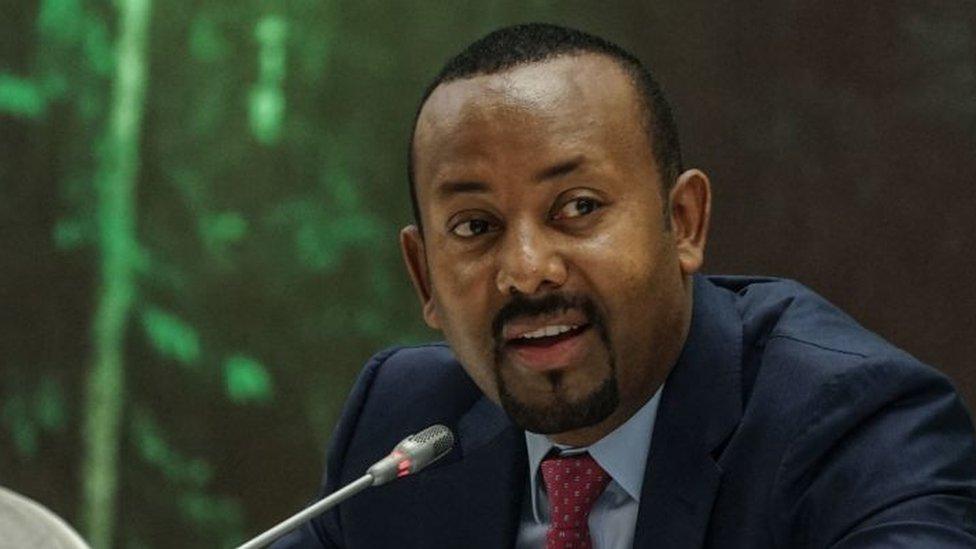Tigray crisis: Why there are fears of civil war in Ethiopia
- Published
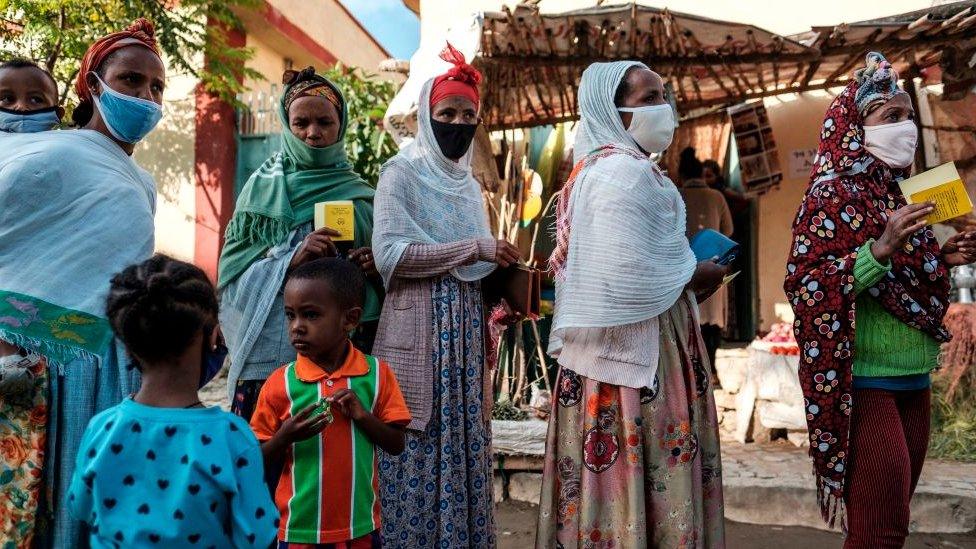
The election held in Tigray in September in defiance of the federal government heightened tensions
Ongoing violence between the national army and forces loyal to the leaders of the northern Tigray region has prompted fears that Ethiopia is on the brink of a civil war.
Hundreds of people have reportedly been killed since the fighting started on 4 November, and thousands have fled into neighbouring Sudan.
What led to the fighting?
September's election in Tigray, which the federal government had postponed nationwide because of coronavirus, is widely considered to be the cause of the recent rapid deterioration.
Prime Minister Abiy Ahmed announced a military offensive after accusing Tigrayan forces of attacking and seizing a military base in the regional capital, Mekelle - a charge they deny.
But the tension has been building for longer.
The Tigray People's Liberation Front (TPLF), which was the dominant political party in Ethiopia for decades, has been feuding with Mr Abiy's government since shortly after he came to power in 2018.
Elected as a "reformist leader", the prime minister accused officials in previous governments of corruption and human rights abuses, and removed key TPLF figures from the central government.
Four things that explain the crisis in the Tigray region of Ethiopia.
This included the former intelligence chief and senior TPLF official, Getachew Asefa, who evaded arrest and fled to Tigray, where he remains as a fugitive.
Mr Abiy's decision last year to merge the ethnically based parties that formed the governing EPRDF coalition and set up the Prosperity Party (PP) added fuel to the tensions. The TPLF opposed the decision, saying it would divide the country, and refused to join the PP.
Earlier this year, the rift grew even wider after the federal government postponed nationwide elections.
Tigray's decision to hold its own vote in September was an unprecedented act of defiance against the federal government. The federal parliament termed the process "illegal".
Since then, both governments have designated each other as "illegitimate and unconstitutional".

A horse in Mekelle painted in the colours of the Tigray flag, which is proudly flown in the region
The TPLF had previously made veiled threats of secession, citing an article in the federal constitution which allows the "unconditional right to self-determination, including the right to secession".
"We will never back down for anyone who is intending to suppress our hard-won right to self-determination and self-rule," the region's leader, Debretsion Gebremichael said in August.
Early in October, the federal government decided to cut ties with the Tigray region and the upper house of parliament voted to suspend budget aid to Tigray.
Why was the TPLF so significant?
Since the overthrow of Marxist leader Mengistu Haile Mariam in 1991 and up until 2018, the TPLF was the main partner in the governing coalition, as well as running Tigray itself.
As a guerrilla army, the TPLF had played a pivotal role in Mengistu's demise and went on to dominate not just the country's politics but the economy as well.
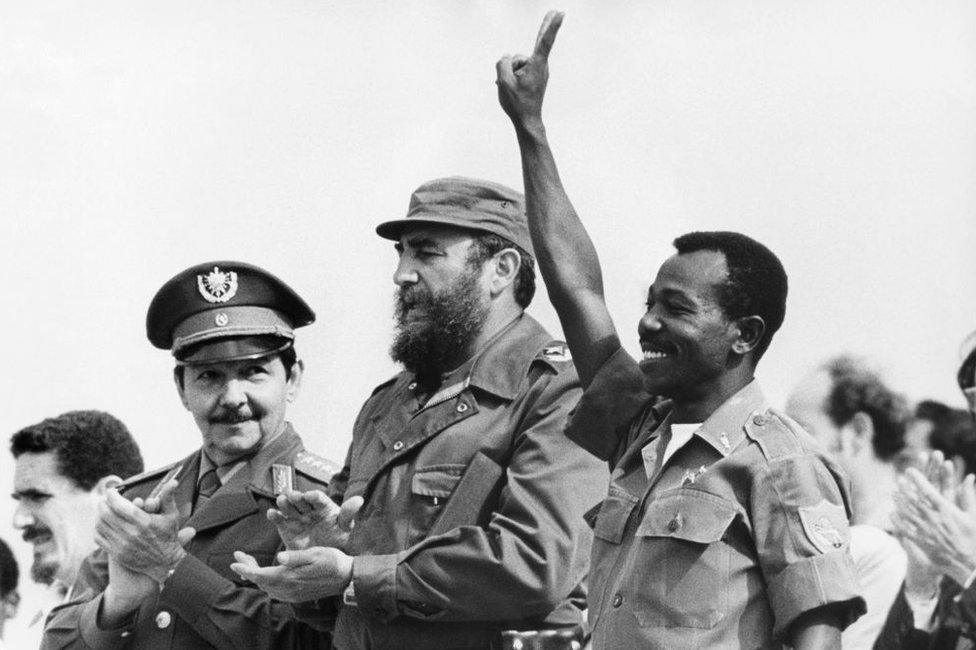
The TPLF was instrumental in the 1991 overthrow of Mengistu Haile Mariam (R), seen here in 1975 with Cuban leader Fidel Castro
Its disagreement with Mr Abiy represents a deep fracture in the very core of power in the country.
Most of the Tigray's regional leaders, including Mr Debretsion, had served in the central government for long periods of time.
Mr Debretsion, who is a veteran fighter, was at one time the deputy prime minister. His comrades and advisers also held key positions in the country until Mr Abiy came to power.
What does the TPLF want?
The Tigray's administration sees Mr Abiy's reforms as an attempt to build a unitary system of government destroying the current federal arrangement.
It also resents what it calls the prime minister's "unprincipled" friendship with Eritrean President Isaias Afwerki.
Mr Abiy won the Nobel Peace Prize in 2019 for his efforts to bring peace with long-standing foe Eritrea. But the TPLF feels that Tigray's interests have been overlooked and it wants to have more say over future relations with Ethiopia's neighbour.
On his part, the prime minister believes the TPLF officials are undermining his authority.
Is Eritrea involved in the Tigray conflict?
There is a long-standing rift between the TPLF and the government in Eritrea, which shares a long border with the Tigray region.
The 1998-2000 Ethiopia-Eritrea war began over a dispute about territory along that border, particularly the area around the town of Badme.
The status of Badme remains unresolved but Eritrea wants Ethiopia to abide by a UN-backed border commission ruling to hand over the town.
But this cannot be achieved without the cooperation of the government in Tigray, as it administers the area.
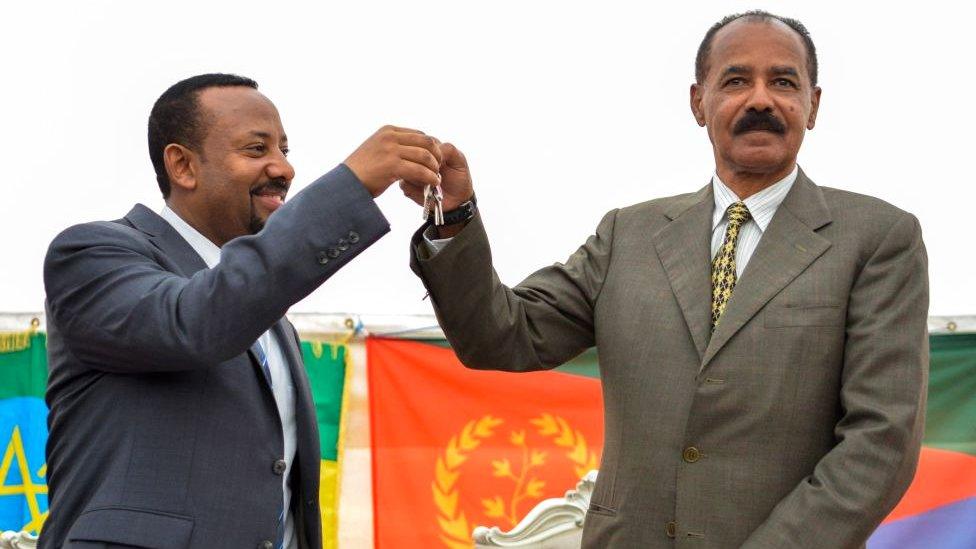
There were celebrations when Prime Minister Abiy (l) agreed a deal with Eritrea's President Isaias Afwerki in 2018
Speaking about the attack on the federal army base, Mr Abiy's office has accused the TPLF of dressing its soldiers in uniforms resembling those of the army of neighbouring Eritrea to "implicate the Eritrean government in false claims of aggression against the people of Tigray".
Tigray's leader, Mr Debretsion, has accused Eritrean forces of joining the fight alongside Ethiopian forces against Tigray. Ethiopia and Eritrea have both denied this.
How likely is a full-scale war?
The Tigray regional leader has said his forces are ready to fight to defend the region, which would be "a burial place for the reactionaries", calling on Tigrayans to understand the situation and make all the necessary preparations. The TPLF has also issued a bond to raise money for its war effort.
"We have prepared our army, our militia and our special force. Our preparation is aimed at averting war, but if we are to fight, we are ready to win," Mr Debretsion said.
In justifying the military confrontation, Mr Abiy's office has accused the TPLF of "continued provocation and incitement of violence" and said "the last red line had been crossed".
He has issued arrest warrants foe the TPLF leaders, appointed a new leader for the region and predicts that the war will soon be over but the TPLF forces are highly trained and experienced so some fear the conflict could drag on.
There is also a concern that the conflict in Tigray, which accounts for about 6% of Ethiopia's population of over 100 million people, could exacerbate tensions in the rest of this ethnically divided country.
Related topics
- Published10 December 2019
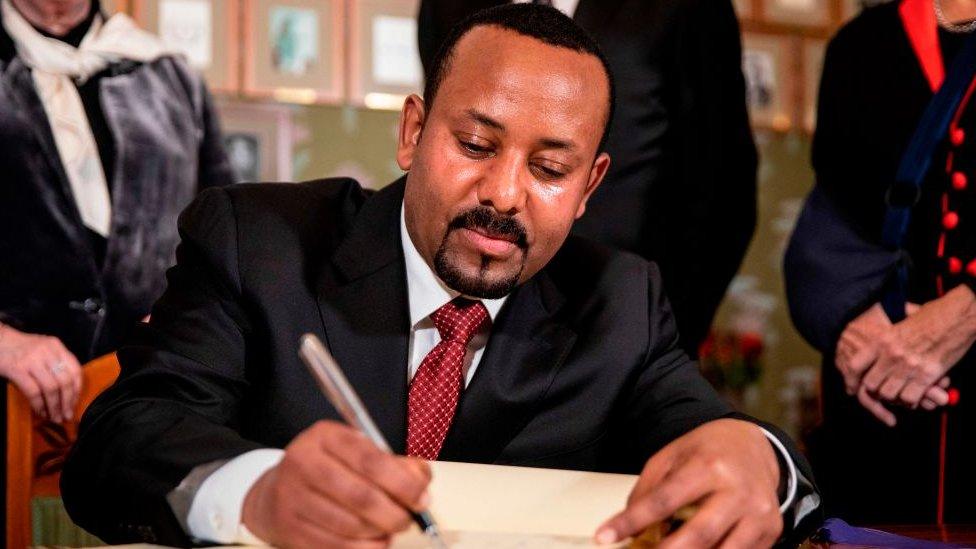
- Published11 October 2021
